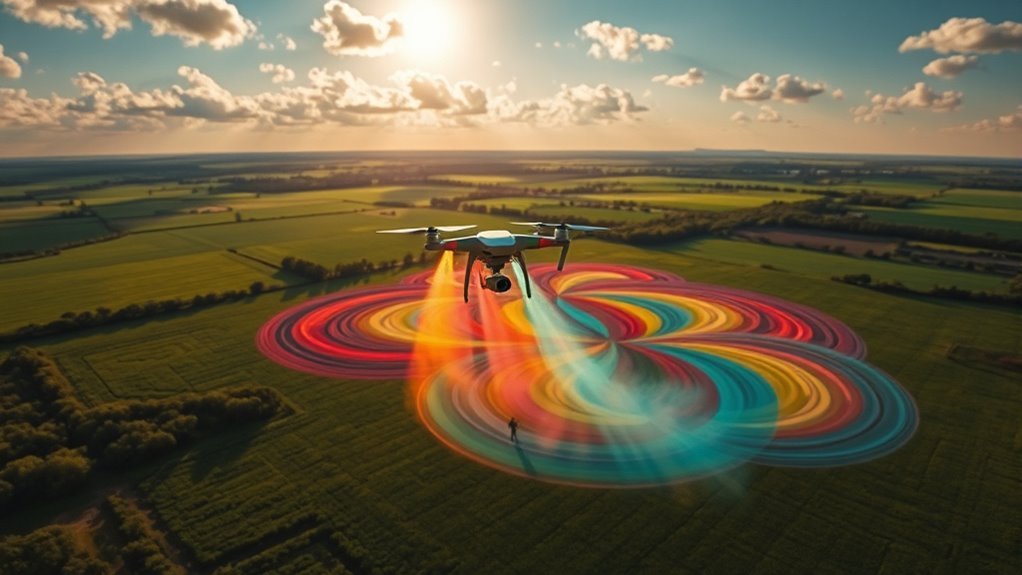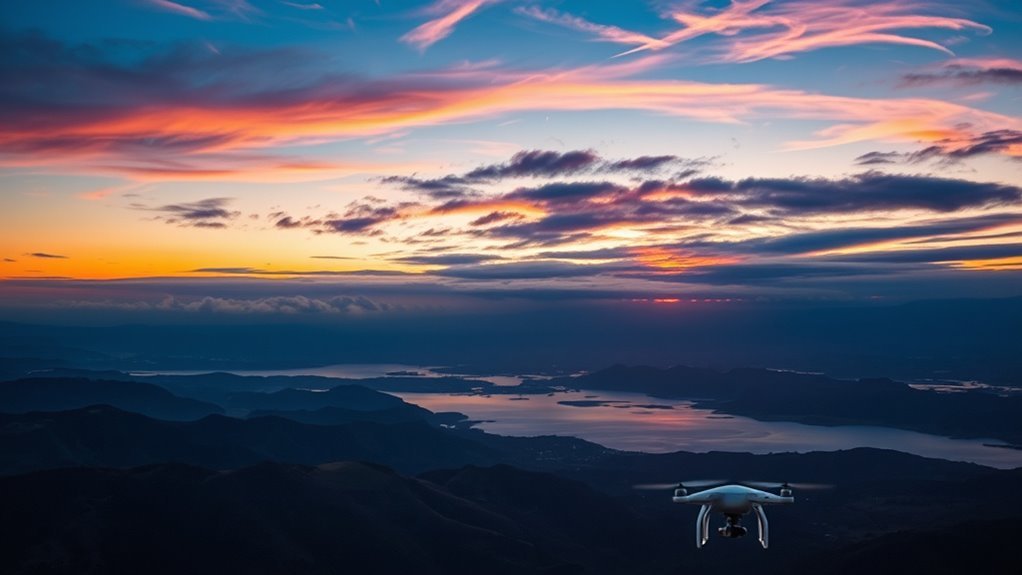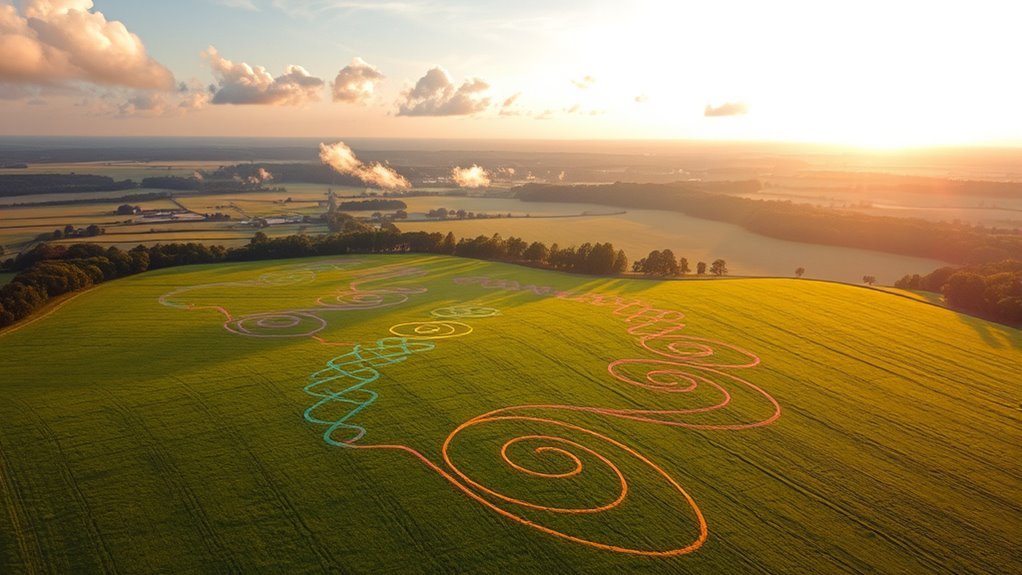To master drone art, start by understanding its unique potential to redefine perspectives. Choose the right drone, emphasizing high-resolution cameras and stable flight. Equip yourself with essential accessories like spare batteries, gimbals, and filters. Focus on honing your flight techniques and familiarize yourself with design principles for impactful compositions. Don’t forget to capture and edit your work for the best results. By embracing these steps, you’ll discover new creative horizons awaiting you.
Understanding Drone Art and Its Potential

Drone art is an exciting intersection of technology and creativity, where aerial perspectives transform everyday scenes into enchanting visuals. As you explore this art form, you’ll discover how to harness the power of drones for artistic expression. The unique vantage point drones provide allows you to capture landscapes, architecture, and events in ways that traditional photography simply can’t match. Additionally, utilizing advanced monitoring and data analytics can provide insights into the subtle features of the terrain you are capturing.
Embracing this innovative medium offers you the freedom to reimagine your surroundings, turning mundane moments into breathtaking compositions. Experimenting with angles and heights can reveal new dimensions of beauty, inspiring your creativity. Additionally, leveraging advanced crop monitoring techniques can enhance your understanding of landscapes and their features. Whether you’re a seasoned artist or just starting, drone art invites you to break boundaries and express yourself like never before. So grab your drone and let your imagination soar!
Selecting the Right Drone for Artistic Endeavors

When you’re ready to plunge into drone art, choosing the right drone is essential for achieving your artistic vision. Start by exploring different drone types. For aerial photography, opt for drones with high-resolution cameras and stable flight capabilities. If you’re focused on creating intricate light displays, look for models that support customizable LED features. Artistic features like GPS tracking and automated flight paths can also enhance your creative process, allowing you to concentrate on your vision rather than the technicalities of flying. Don’t forget to take into account the drone’s ease of use, battery life, and range. Ultimately, selecting a drone that aligns with your artistic goals will empower you to express your creativity freely and effectively. Additionally, consider the drone’s flight time and battery performance, as these factors significantly impact your ability to capture the perfect shot during longer sessions. For instance, the DJI Mavic 3 Enterprise offers superior battery life compared to many competitors, enhancing your creative opportunities.
Essential Equipment and Accessories for Drone Art

While selecting the right drone is essential, having the necessary equipment and accessories can greatly elevate your drone art experience. Start with high-quality batteries; they’ll guarantee longer flight times, allowing you to fully explore your creative vision. A sturdy carrying case is important for protecting your gear during transport. Don’t forget spare propellers and tools for quick repairs—creativity shouldn’t be interrupted! Additionally, consider a gimbal for steady shots, enhancing the quality of your artwork, as the advanced three-axis gimbal stabilizes your footage for a professional look. Incorporating filters can add unique effects, expanding your palette of creative tools. The Potensic 4K gimbal significantly minimizes vibrations, ensuring your footage remains smooth and professional. Finally, a reliable smartphone or tablet can help you control your drone and capture your artistic moments effortlessly. With the right drone accessories, you can release your imagination and take your drone art to new heights!
Mastering Drone Flight Techniques for Artistic Precision
With the right equipment and accessories in hand, mastering flight techniques becomes the next step in elevating your drone art. Focus on honing your drone maneuvers to achieve fluidity in your movements. Start with basic navigational skills, then gradually incorporate advanced techniques like yawing and tilting for dynamic shots.
Artistic calibration is essential; it guarantees your drone’s camera settings complement your vision. For instance, the drone’s advanced camera capabilities can significantly enhance your photographic outcomes. Experiment with different angles and heights to find what resonates with your style. Practice makes perfect, so don’t be afraid to take your time and refine your skills. Additionally, consider the superior wind resistance of your drone, as it plays a crucial role in maintaining stability during your artistic flights.
Embrace the freedom that drone art offers, and let your creativity soar as you perfect these flight techniques. The sky’s the limit—literally!
Exploring Design Principles and Composition
Understanding design principles and composition is vital for creating engaging drone art, as it allows you to convey your artistic vision effectively. Start by familiarizing yourself with basic design elements like line, shape, and color. These elements form the foundation of your artwork, guiding the viewer’s eye and creating a narrative. Visual balance is essential; guarantee your composition feels harmonious by distributing visual weight evenly. Experiment with symmetry and asymmetry to find what resonates with your style. Remember, negative space can enhance your design, drawing attention to your focal points. Embrace your creativity and don’t hesitate to break conventional rules. The beauty of drone art lies in your ability to express freedom, so let your imagination soar as you explore these principles. Additionally, understanding how battery life affects the overall performance of drones can inspire unique artistic interpretations of aerial dynamics. Furthermore, incorporating knowledge of signal strength can enhance your ability to depict the nuances of drone operation in your art.
Planning Your Aerial Artwork: Sketching and Mapping
Planning your aerial artwork is an essential step in bringing your vision to life, and having a solid sketch or map can make all the difference. Start with aerial sketching to visualize your ideas. Use different mapping techniques to outline your design and determine the best flight paths for your drone. The DJI Mavic Pro, known for its high-quality 4K camera, can significantly enhance the quality of your aerial imagery. With its advanced image stabilization systems, you can achieve smooth and professional-looking shots even in challenging conditions.
Here’s a helpful table to guide your planning process:
| Step | Description | Tools Needed |
|---|---|---|
| Conceptualize | Develop your main idea | Sketchbook, Pencil |
| Map It Out | Create detailed flight paths | Software, GPS |
| Review | Evaluate design feasibility | Feedback tools |
| Refine | Adjust your plan as needed | Editing software |
| Execute | Bring your artwork to life | Drone, Camera |
Embrace the freedom of creativity as you prepare for your aerial masterpiece!
Capturing and Editing Your Drone Art
To truly bring your aerial artwork to life, mastering drone photography techniques is essential. You’ll want to explore various angles and lighting conditions to capture the best shots. Once you’ve got your images, using post-processing software can elevate your work, helping you refine and enhance your visuals. Incorporating 5.1K video resolution can significantly enhance the detail and precision of your captures, making your artwork stand out even more.
Drone Photography Techniques
Capturing stunning drone art hinges on mastering both aerial photography techniques and post-processing skills. To get started, adjust your drone settings to optimize image quality. Experiment with different ISO levels and shutter speeds to suit various lighting conditions. When flying, focus on unique aerial perspectives that highlight the landscape’s beauty. Look for patterns, textures, and contrasts that can transform an ordinary scene into extraordinary art. Always remember to maintain stability while capturing your shots to avoid blurry images. Additionally, practice framing your shots by using the rule of thirds, which can enhance visual appeal. Your creativity is your limit, so don’t hesitate to explore and capture the world from above. Embrace the freedom that drone photography offers!
Post-Processing Software Tips
While the magic of drone art begins in the sky, it truly comes to life in post-processing. To enhance your creations, explore various post-processing techniques that can elevate your images. Start with software recommendations like Adobe Lightroom or Photoshop for robust editing capabilities. These tools allow you to adjust colors, contrast, and sharpness, bringing your vision to life. Don’t forget about specialized software like DroneDeploy for mapping and visualization, which can add depth to your art. Experiment with filters and presets to create unique styles that resonate with your artistic voice. Remember, the goal is to express your freedom through your work, so let your creativity soar in the editing room too!
Showcasing Your Work and Engaging With the Community
How can you effectively showcase your drone art and connect with fellow enthusiasts? Engaging with the community is essential for sharing your talent and getting constructive feedback. Start by leveraging social media platforms and specialized forums where drone art is celebrated.
- Create a visually appealing portfolio to highlight your best work.
- Participate in local drone meetups or online challenges to network and share experiences.
- Collaborate with other artists to inspire and expand your creative horizons.
Don’t be afraid to share your unique perspective; your freedom of expression adds value to the community. By showcasing your talent and engaging with others, you’ll not only improve your skills but also build lasting connections with like-minded individuals.
Frequently Asked Questions
What Are the Legal Regulations for Flying Drones in My Area?
You should check your local laws regarding drone regulations, as they can vary considerably. Understanding these rules will help you fly safely and responsibly, ensuring you enjoy the freedom of drone flying without legal complications.
How Can I Protect My Drone While Creating Art?
To protect your drone while creating art, consider investing in drone insurance for peace of mind. Additionally, using protective gear, like padded cases and propeller guards, will help safeguard your equipment from potential damage. Enjoy your creative freedom!
What Are Common Mistakes Beginners Make in Drone Art?
When painting a masterpiece, choosing the wrong colors can ruin your vision. Similarly, beginners often overlook color selection and flight stability in drone art. Focus on these elements, and you’ll elevate your creative freedom.
How Do Weather Conditions Affect Drone Art Creation?
Weather conditions can greatly impact your drone art. Wind patterns might cause unstable footage, while lighting conditions affect colors and visibility. Pay attention to these factors to enhance your creative freedom and capture stunning visuals.
Can I Sell My Drone Art Commercially?
Yes, you can sell your drone art commercially! Research commercial licensing options and explore art marketing strategies to reach potential buyers. Embrace your creativity, and don’t hesitate to share your unique vision with the world.

